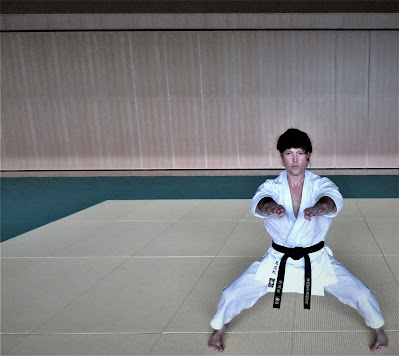蹲踞 (SONKYO) is a methodology of basic sitting in which the body is curled up and crouched—in Japanese; in other words, the knees are folded and the hips are lowered.

In Sumo and
Kendo, it is posture of courtesy made prior to the engagement in a match. In the
case of Sumo, it is the state where “… the hips are placed on the heels whilst
standing on josokutei (the balls of the feet). The hips are lowered, the knees
are splayed open, and the johanshin (upper body) is raised. Kendo follows a
similar process.
In karate,
especially the form I was taught we have many 蹲踞技
(SONKYO-WAZA). In particular, 蹲踞 突き (sonkyo-zuki); but also, uke, keri, ashi-barai, and uchi from this position. All of which are extremely useful exercises for Budo/Bujutsu development.
This is
because these waza, and renzokuwaza, force one to move with the correct form; moreover, in a
relaxed manner because the Sonkyo position is comparitively destabilized and, hence,
demands relaxation, control of balance, and certainly 'mindfulness'.
We have official Sonkyo exercises—in the IKS (International Karate Shotokan)—which are are not for ‘looking nice’ but, rather, to immensely lift the level of people’s karate. These range from stationary drills, ido-kihon, tenshin (rotation/spinning without superfluous actions), use of jumping and combinations of all these elements.
Lastly, I will reiterate… Sonkyo-waza are not a means to ‘feel good’ or ‘look nice’. Instead, they are training exercises to find weaknesses then provide an avenue to refine one’s skills, balance, core strength and later power, and the relaxation of the right muscles at the right times (especially pertaining to the limbs).
 |
| Sonkyo training masters kiba-dachi and centralization. |
Best wishes from Japan's Autumn/Fall. Osu, André

No comments:
Post a Comment